Costumes Add Color to Your Unit Studies
By Jessica Hulcy
Printed in Practical Homeschooling #4, 1993.
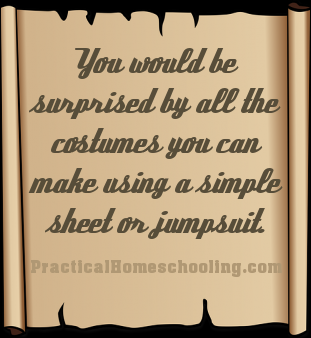 Jessica Hulcy shows us how to make inexpensive costumes to adorn young actors.
Jessica Hulcy shows us how to make inexpensive costumes to adorn young actors.

|
 |
 Edith Head "costumed" Hollywood for years, winning several Oscars in the process. My husband, Wade, jokingly calls me the "Edith Head of home schooling" since our costume closet bulges. But the Oscars I seek are imagination unlocked and memories created.
Edith Head "costumed" Hollywood for years, winning several Oscars in the process. My husband, Wade, jokingly calls me the "Edith Head of home schooling" since our costume closet bulges. But the Oscars I seek are imagination unlocked and memories created.
Children love to dress up and dramatize. What a fun way to reinforce what you are studying!
Out of necessity, our family's costume items must be low-budget, easy or no-sew, and serve a multitude of purposes. Four basics in a well-stocked repertoire are:
- the tunic,
- a gray sweat suit,
- a linen, wool, or velvet women's jacket,
- and a prairie skirt.
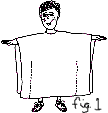 Tunic Time. The standard tunic spans millions of costume needs and historical periods and is easy to make. Use cotton fabric in brown, burgundy, purple, or striped that is 36 inches wide for very young children or 56 inches wide for older children (Fig. 1). Measure the height of the child from neck to toe. Double that measurement and add 12 to 16 inches for hem and "growing room."
Tunic Time. The standard tunic spans millions of costume needs and historical periods and is easy to make. Use cotton fabric in brown, burgundy, purple, or striped that is 36 inches wide for very young children or 56 inches wide for older children (Fig. 1). Measure the height of the child from neck to toe. Double that measurement and add 12 to 16 inches for hem and "growing room."
 Hem the two ends. Fold the fabric in half. Come in 8 inches from the side and stitch the side to about waist level on the child's body. Cut a small head hole with a slit in the back (Fig. 2), and voila -- a tunic!
Hem the two ends. Fold the fabric in half. Come in 8 inches from the side and stitch the side to about waist level on the child's body. Cut a small head hole with a slit in the back (Fig. 2), and voila -- a tunic!
A tunic was a clothing basic from Bible times to medieval times to modern African attire. It even becomes a monk's robe. Just change the accessories to change the time period!
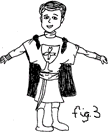 To create a medieval knight's look, temporarily hem the tunic shorter with masking tape and place it over a turtleneck with boots and tights (Fig. 3). A crest made from construction paper is pinned to the front of the tunic while an old scarf is rolled to make a belt. A three-foot-square piece of light-blue material is used to make a cape pinned to the shoulders. Mom's leather gloves and a sword complete the costume.
To create a medieval knight's look, temporarily hem the tunic shorter with masking tape and place it over a turtleneck with boots and tights (Fig. 3). A crest made from construction paper is pinned to the front of the tunic while an old scarf is rolled to make a belt. A three-foot-square piece of light-blue material is used to make a cape pinned to the shoulders. Mom's leather gloves and a sword complete the costume.
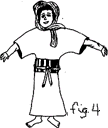 For female Bible characters (Fig. 4), add stiff 6-inch-wide upholstery-like fabric wrapped around the waist and tied in place with old scarves or rope. The 3 x 3 light blue piece becomes the head piece. For Bible men, use old bath towels held in place with fabric strips or scarves. If a 1930's woman's dress hat is added, the costume becomes distinctively African. The costume uses of the tunic are endless!
For female Bible characters (Fig. 4), add stiff 6-inch-wide upholstery-like fabric wrapped around the waist and tied in place with old scarves or rope. The 3 x 3 light blue piece becomes the head piece. For Bible men, use old bath towels held in place with fabric strips or scarves. If a 1930's woman's dress hat is added, the costume becomes distinctively African. The costume uses of the tunic are endless!
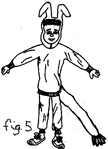 Sweatsuit Surprises. What can you make out of a large gray sweat suit? Here are two choices. First, a donkey costume (Fig. 5). Hot glue a head piece of gray felt (the greatest cloth ever invented). Use black fringe in front. Velcro around the neck with
Sweatsuit Surprises. What can you make out of a large gray sweat suit? Here are two choices. First, a donkey costume (Fig. 5). Hot glue a head piece of gray felt (the greatest cloth ever invented). Use black fringe in front. Velcro around the neck with
 popsicle sticks to make the ears stand up. Sandwich popsicle sticks between two pieces of felt for each ear so the sticks won't show. Use one leg of gray stuffed panty hose for a tail. Now you are ready for a Nativity play!
popsicle sticks to make the ears stand up. Sandwich popsicle sticks between two pieces of felt for each ear so the sticks won't show. Use one leg of gray stuffed panty hose for a tail. Now you are ready for a Nativity play!
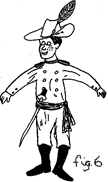 Next, use the sweat suit to create a Civil War uniform (Fig. 6). Add six shiny gold or silver buttons to the front and two smaller buttons to each sleeve. For the epaulettes cut the red or gold stripe out of an old soccer sock and stitch it on the shoulders. More elaborate epaulettes with fringe can be made if desired. Push the sweat pants up, add boots and tie the gold piece of fabric around the waist and add a sword. An old cowboy hat or a fedora with one side pinned up and a plume placed in it tops off a real Stonewall Jackson uniform. You must be south of the Mason Dixon Line to wear this uniform properly!
Next, use the sweat suit to create a Civil War uniform (Fig. 6). Add six shiny gold or silver buttons to the front and two smaller buttons to each sleeve. For the epaulettes cut the red or gold stripe out of an old soccer sock and stitch it on the shoulders. More elaborate epaulettes with fringe can be made if desired. Push the sweat pants up, add boots and tie the gold piece of fabric around the waist and add a sword. An old cowboy hat or a fedora with one side pinned up and a plume placed in it tops off a real Stonewall Jackson uniform. You must be south of the Mason Dixon Line to wear this uniform properly!
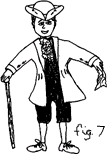 Jacket Jamboree. Mom's 1960's jackets and puffed long-sleeved blouses are a must for any costume repertoire. To attire a colonial gentleman such as George Washington (Fig. 7), use tights or soccer socks, Sunday dress shoes, pushed up sweat pants and Mom's old blouse buttoned to the neck with a bunch of lace pinned to the front. We use an old white lace mantilla, which has many other uses besides, for the gentleman's lace at the neck. If you have a vest, all the better.
Jacket Jamboree. Mom's 1960's jackets and puffed long-sleeved blouses are a must for any costume repertoire. To attire a colonial gentleman such as George Washington (Fig. 7), use tights or soccer socks, Sunday dress shoes, pushed up sweat pants and Mom's old blouse buttoned to the neck with a bunch of lace pinned to the front. We use an old white lace mantilla, which has many other uses besides, for the gentleman's lace at the neck. If you have a vest, all the better.
To make a woman's jacket "colonial looking" take tucks or darts in the waist area with stitching or safety pins and turn the sleeves up to make cuffs. Any old cowboy hat pinned up in three places makes a three-cornered hat for the guys. If you add a cane and handkerchief with which the gentleman may dab his brow, you will have a true Founding Father. A white wig can easily be made from
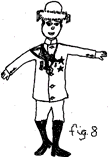 batting but is not necessary.
batting but is not necessary.
The same velvet or wool jacket without tucks at the waist and pinned tightly at the neck can be used as a Russian Czar's costume (Fig. 8). By adding gold chains, ribbons, cardboard stars and scarves, the look of royalty is created. Sweat pants and boots complete the bottom of the costume. A fur hat begged from Mom or picked up at a yard sale makes a terrific Russian hat. If no hat can be found, hot glue fur to the cap portion of an old baseball cap with the bill removed. Ta-da!
 Prairie Skirt Party. The prairie skirt is the is the most utilitarian skirt for girls. For a colonial lady (Fig. 9), put it with a long sleeve blouse and the 3 x 3 light blue square fabric folded in a triangle and tied or held in front with a brooch. Add an apron and wear hair up in a bun.
Prairie Skirt Party. The prairie skirt is the is the most utilitarian skirt for girls. For a colonial lady (Fig. 9), put it with a long sleeve blouse and the 3 x 3 light blue square fabric folded in a triangle and tied or held in front with a brooch. Add an apron and wear hair up in a bun.
 For an Indian maiden (Fig 10), use the same prairie skirt with an Indian headband and either a large fake chamois or a large piece of fake fur with a head hole cut in it to form the top and bottom of the costume. Girls can add all kinds of jewelry and feathers, braid their hair, and wrap their feet in strips of cloth to look more like an authentic Indian.
For an Indian maiden (Fig 10), use the same prairie skirt with an Indian headband and either a large fake chamois or a large piece of fake fur with a head hole cut in it to form the top and bottom of the costume. Girls can add all kinds of jewelry and feathers, braid their hair, and wrap their feet in strips of cloth to look more like an authentic Indian.
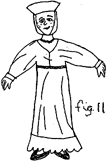 A medieval maiden (Fig. 11) uses the same skirt worn just below the bustline with a long-sleeved blouse that has the collar turned under. Pearls at the neck, slippers for the shoes, a white scarf under the chin and tied on the top of the head and a white cardboard headpiece produce a lady out of Camelot.
A medieval maiden (Fig. 11) uses the same skirt worn just below the bustline with a long-sleeved blouse that has the collar turned under. Pearls at the neck, slippers for the shoes, a white scarf under the chin and tied on the top of the head and a white cardboard headpiece produce a lady out of Camelot.
Why go to all of this trouble? Couldn't children be satisfied with just reading about all of these different periods in history? I suppose some could, but I have hatched a dramatic brood. In fact, I seldom see my five-year-old in normal clothes. He is always in costume pretending to be George Washington or some other historical figure.
Our costume department has unlocked imaginations, created memories, aided in retention of facts, and been the catalyst for so many smiles. I encourage you to start your own simple costume department and be on the lookout for those special accessories that spark imagination!